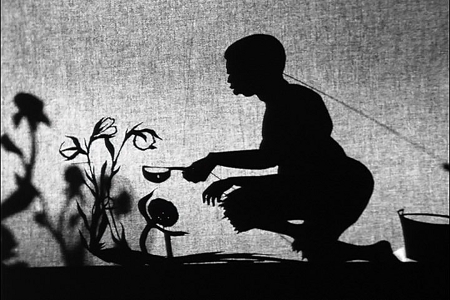INFORMATION - PEOPLE

Kara Elizabeth Walker, born 26 November 1969 is a highly controversial and talented African American artist who explores issues of race, gender and sexuality. Walker uses a range of techniques including drawing, water colours, notecards, video, text, and her signature silhouettes, depicting violent and grotesque scenes between blacks and whites in the Antebellum South. Walker approaches the intimate themes of oppression, gender and race in an uninhibited, head-on manner. Her figures often have physical characteristics of the most extreme stereotypes, and the scenes created refer to issues such as child exploitation, inter-racial relationships and violence, frequently juxtaposed with a humorous and surreal approach. She has been extremely successful, with world wide exhibitions and many awards to her name. However, due to the subject of her work, Walker has generated much controversy and debate about art, race and history.
Of all the methods Walker uses, most famous is her use of the elegant 18th century medium of, almost life sized, cut-out silhouettes. This approach renders all subjects literally black which, in effect, removes skin colour as a part of appearance. Furthermore, it means the subjects do not have facial expressions and their bodies often melt into one another, leaving the viewer in control: interpreting these undetailed shapes and scenes. This is an important aspect of her work; Walker, explaining the connection between her techniques and the issues she addresses, said, “Silhouettes are reductions, and racial stereotypes are also reductions of actual human beings” . The effect is very provocative. To differentiate between 'races', Walker employs stereotypical physical characteristics such as big lips for black characters, and long noses for white characters, but this is not where is ends.
Scenes of the antebellum South have unexpected twists; the Southern belle of Harlequin romance novels is present, distinctively dainty in billowy dresses but often committing violent and evil actions. Whites are not the only villains however, it seems no one is innocent. Amongst the many images slave women are depicted as enjoying or encouraging sexual relations with white masters and children are equally as sexual and violent. Walker problematises what the viewer knows or is taught to know about race and slavery, and the use of silhouettes compounds this effect. The impact of this unusual medium and different (to say the least) approach to the subject matter is multifaceted; the viewer is shocked, disgusted, amused or ashamed, or a mixture of all these emotions. There is not necessarily a clear message with each piece, they can be contradictory and non linear, there is not always an obvious ‘baddie’ or ‘goodie’. This creates an exploration into race and the legacy of slavery like never before.
An important dimension to Walker’s work is her creation of an alternative history or ‘counter-memory’ of slavery. Although there is much scholarship exploring the history of transatlantic slavery and its many manifestations in the societies of the Americas, Walker chooses to further depict slave plantation life. This ‘history’ is a nightmarish and surreal non-stop cycle of violence, desire and oppression. Darby English discusses this in great depth and states that ‘Walker’s work suggests that a certain re-witnessing of the past, without benefit of comfort or clear vision, is required to produce a sense of history that does not finally reconcile the systematic denigration of our subjectivity within us- but instead provides a way of possessing our complexity in spite of it.’
Rebecca Peabody’s PhD thesis, ‘A Strategic Cut: Kara Walker’s Art and Imagined Race in American Visual Culture’ looks in detail at the idea of constructing a fictional history. She argues that there are dangers in this practice as people begin to believe these fictions over fact. However, as Kevin Young states, “Walker is less an artist of history, whether racial or artistic history, than a historian of fantasy.” Walker herself describes her work as “two parts research and one part paranoid hysteria.” This fusion of fact and fiction probes ideas of ‘truth’, particularly in the context of ‘identity’ and ‘race’, and in doing so, also reveals that much of African American, American, or indeed just history is itself constructed. The scholar Hamza Walker explains “The works refusal to acknowledge shame when dealing with issues of race and desire set within the context of slavery, allows Walker to challenge, indeed taunt, our individual and collective historical imaginations.”
Walker’s created histories allow her to reflect on and discuss contemporary issues in her work. Indeed she states, “I think my work sort of mimics the past, but it’s all about the present. Oh, some great artist in the past, Courbet or somebody, said there’s no historical art that isn’t about present…” Although the images Walker creates directly refer to slavery, they are not limited to a single temporality. Rather than commenting only on transatlantic slavery, Walker explores the legacies of enslavement and particularly the role of ‘blackness’ in contemporary culture. Mark Reinhardt’s essay ‘The Art of Racial Profiling’ looks in greater detail at the relevance and context of the images produced by Walker. He considers the ever present issues of race in society in terms of law enforcement and media and explores the uses of Walker’s work. “She does not give us a world of redemption in suffering and virtue in victimhood… in taking up old fantasies and familiar idioms, she has found a new way of picturing the politics of race.”
Walker was born in Stockton California. Her father was a painter and teacher and a source of inspiration to her as a child. Aged 13, her family moved to Atlanta, Georgia. This change is what Walker has described as ‘the culture-shock that defined my life’ as she was here exposed to racism and discrimination that she had no exposure to when in California and it presented to her a new understanding of race. She said of the subject ? read more
Contributed by HGF
 |
Continue the debate on Kara Walker |
Return to People home